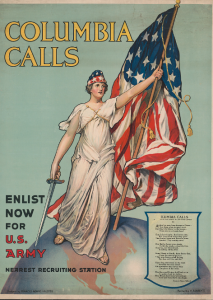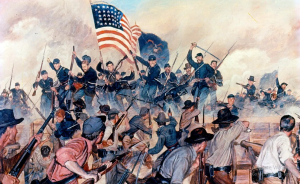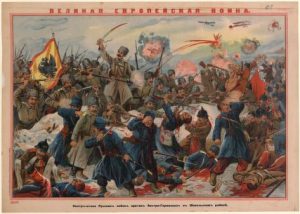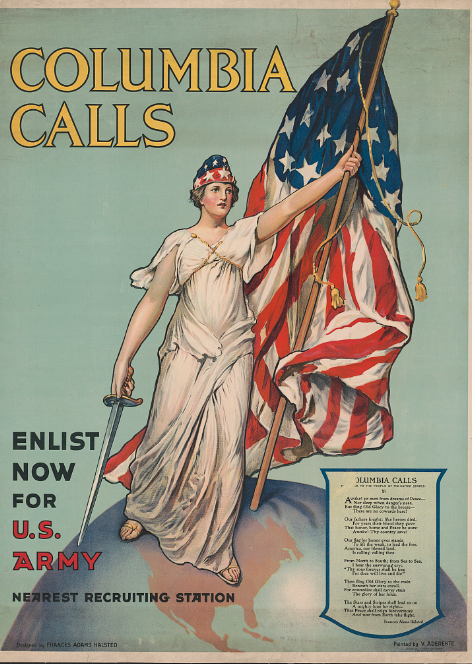
“Enlist Now for U.S Army”
The World War I poster titled “Columbia Calls” was created in 1916 by Frances Adams Halsted and illustrated by V. Aderente. The poster was meant to encourage young men to join the U.S. Army during a time where America was still deciding whether or not to enter the war. The poster shows Columbia, a traditional symbol of America, dressed in white and holding both a sword and the U.S. flag. She stands on top of a globe with a strong and determined posture, as if she is inspiring pride and calling on the viewer to take action. Her pose and expression create a sense of confidence and purpose, which helped make enlistment feel like a patriotic duty.
During this time, the Great War was going on from 1914 to 1918. It was the most destructive conflict the world had ever seen up to that point. As explained in the textbook America: A Narrative History, the war “involved more nations and caused greater destruction than any previous conflict: 20 million military and civilian deaths, and 21 million more wounded.”¹ It also “toppled monarchs, destroyed empires, and created new nations.”² Because of all this global chaos, many Americans began to feel that the war would eventually affect them and started thinking about what the United States should do.

U.S Army
In April 1917, the United States officially entered the war. President Woodrow Wilson told Congress that it was time for America to act “for rights of nations great and small and the privilege of men everywhere to choose their way of life and of obedience. The world must be made safe for democracy.”³ The message behind Wilson’s words appears clearly in “Columbia Calls.” Columbia represents the call to defend democracy and protect the nation’s freedom both at home and overseas. At the same time, not all Americans supported entering the war. Kazin notes that “opponents of militarism could be found in nearly every corner of the social and economic landscape.”⁴ Because of this, posters like “Columbia Calls” were created to persuade people who were unsure or against the war by appealing to their emotions and patriotism. The bold colors like red, white, and blue stands out to the viewers’ eyes. Columbia’s confident expression and the flowing American flag behind her were meant to make joining the Army feel honorable and meaningful.

Great War
When the United States joined the war, the military was not prepared for a conflict of this dimension. As the textbook America: A Narrative History states, “The U.S. Army remained small, untested, and poorly armed… the Wilson administration needed to recruit, equip, and train millions of soldiers and transport them across an ocean infested with German submarines.”⁵ The country needed a massive expansion of its soldiers, which meant convincing millions of men to enlist quickly. According to Lofgren, “America’s entry into World War I demanded the rapid expansion of the United States Army from just over 100,000 men in 1916 to almost four million in 1918.”⁶ Posters like “Columbia Calls” were a major part of that effort.
The poster shows how powerful images and simple messages can influence people. It represents a turning point when America began to see itself as a defender of democracy and freedom. Through its patriotic colors, its inspiring message, and its strong central figure, the poster helped bring Americans together during one of the most destructive wars in history.
Footnote:
1. David Shi, Joanne Freeman, and others, America: A Narrative History, 13th ed. (New York: W. W. Norton & Company, 2025), 978.
2. Ibid, 978.
3. Michael Kazin, “America and the Great War,” Raritan 34, no. 1 (2014): 85, https://research.ebsco.com/linkprocessor/plink?id=ff1d8651-ac60-3c31-a902-cabc9fbf23ed.
4. Ibid, 77.
5. David Shi, Joanne Freeman, and others, America: A Narrative History, 13th ed. (New York: W. W. Norton & Company, 2025), 989.
6. Stephen J. Lofgren, “Unready for War: The Army and World War I,” Army History, no. 22 (1992): 11, http://www.jstor.org/stable/26302891.
